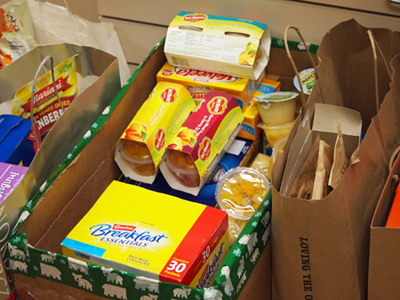
Chronic Childhood Hunger
When a child does not have access to regular meals and is uncertain of when they may eat again they are experiencing the epidemic known as “chronic childhood hunger.” Families that cannot afford food or do not have regular access to food are considered “food insecure.”
Kids experiencing chronic hunger may not only suffer from poor health, they can also be denied the opportunity to reach their academic, athletic and social potential. Chronically hungry students may have the following issues in the classroom:
- Lack of concentration
- Lethargy or general fatigue
- Stomachaches
- Headaches
- Irritability or mood swings
- Disciplinary problems
- Increased aggression

Recent studies from the American Academy of Pediatrics have shown that the effects of chronic childhood hunger can last a lifetime. Not knowing when they may have another meal can cause both anxiety and depression.
Hunger and Poverty in our Community
Hunger and poverty go hand in hand, which is why it is useful to use poverty statistics as a base for hunger statistics.
Chronic childhood hunger exists both above and below the poverty line, as the Federal guidelines for poverty are considered out of date.
- To be considered 100% of poverty, a family of four must earn less than $23,050 per year.
- To be eligible for reduced lunch, a family must be at 130% of the federal poverty line or earn less than $40,793 per year.
- To be eligible for free lunch, a family must earn less than 185% of the federal poverty line or $28,665 per year.
In Colorado, 17% of kids live in poverty
The number of children in poverty has more than doubled since 2000 and the number of children living in extreme poverty (approximately $11,000 for a family of four) has increased 150 percent.
While the childhood poverty rate in Colorado currently remains below the national average, between 2000 and 2009 the number of children living in poverty in Colorado more than doubled, rising faster than any other state in the nation.
School Meal Programs
In Colorado, there has been a steady increase in the number of children participating in the School Breakfast Program. The U.S. increased four percent in the number of children served by the free breakfast program since 2008, while the number of Colorado children increased more than twice as fast with a nine percent increase over the same period.
According to the United States Department of Agriculture, more than 54,000 additional children participated in the National School Lunch Program in Colorado in 2009 than in 2005.
In Jefferson County, there are over 27,000 children who are eligible for free and or reduced lunch programs. Here in Golden, there are over 1,100 children eligible.
+Data compiled from the Kids Count Colorado 2011 Report










